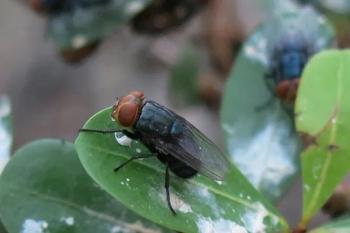
Practitioner revisits encounter with monkeypox
Wauwatosa, Wis.—As government scientists analyze the 2003 monkeypox outbreaks that spread across six Midwestern states, one veterinarian relives the epidemic as the first U.S. practitioner to encounter and contract the rare viral disease.
WAUWATOSA, WIS.— As government scientists analyze the 2003 monkeypox outbreaks that spread across six Midwestern states, one veterinarian relives the epidemic as the first U.S. practitioner to encounter and contract the rare viral disease.
Monkeypox up close: According to the Centers for Disease Control and Prevention, the U.S. strain of monkeypox appeared similar to isolates found in West Africa. Capsular and mulberry refer to two forms of any orthopoxvirus produced during its lifecycle. Depending on stain penetration, the surface of "M" virions are covered with short, whorled filiments while "C" form various present a sharply defined, dense core surrounded by several zones of differing densities.
Dr. Kurt Zaeske, a solo practice owner in Wauwatosa, Wis., tells his story in response to DVM Newsmagazine's April cover article "Report: Practitioner key to containing outbreaks." As the initial veterinarian to treat the handful of prairie dogs now blamed for spreading monkeypox, Zaeske contends the virus was not expressed as some might think. Based on the experience that left him injured and hospitalized, Zaeske urges practitioners to think "outside the box," especially when treating imported animals. Disease indicators often are not what they seem, he says.
"There was no way I could have anticipated monkeypox," Zaeske says. "The animals never had any lesions, so there was no reason to suspect a pox virus. What they appeared to suffer from was shipping fever and seemed to get better with the antibiotics I prescribed for them."
Monkeypox: detection, prevention measures
Disease development
That was in April 2003, when Zaeske's client, an animal distributor in Illinois, alerted the DVM to a sick Gambian rat from Africa that died along with several ill prairie dogs. At the time, foreign infection was not suspected, Zaeske says.
"The rat died and was destroyed prior to any diagnostics," he says. "It wasn't until a young child who bought one of my client's prairie dogs came down with pox lesions that we knew we were dealing with an exotic disease."
The 3-year-old girl thought to have contracted smallpox was the first of 79 people eventually diagnosed with monkeypox, a less-severe virus, throughout Wisconsin, Ohio, Illinois, Indiana, Kansas and Michigan, the Centers for Disease Control and Prevention (CDC) reports. Prior to the virus' detection, Zaeske had traveled to several locations treating prairie dogs with antibiotics for what he thought was shipping fever pneumonia. By the second week in May, he began treating himself.
"I noticed a non-healing blister on my hand and about a week later, I started developing a pustule on my thumb, so I lanced it, and it turned black," he says. "Vets get a lot of stuff on their hands; I didn't pay attention to it at first. But then my client expressed concern that he was sick, and soon after, I started getting hot and cold sweats, mild nausea and dizziness."
Hospitalized
Zaeske checked in to Froedtert Hospital within the Medical College of Wisconsin in Milwaukee. With the veterinarian and his client in for treatment, infectious control specialists began making connections. Mary Beth Graham, MD, says she was perplexed initially.
"Everything was negative, no plague or tularemia, nothing," she says. "With Dr. Zaeske's and the distributor's help, we tracked down the possible source, and that expedited things for us and the CDC. I never thought it would be monkeypox."
Following the discovery, she called her father, a veterinarian.
"I told my dad point blank, 'I want you wearing gloves, and I want you wearing a mask,'" she says. "It's what every veterinarian should be doing. That's just common sense."
Government takeover
With Zaeske hospitalized, the CDC took action. In June 2003, the agency quarantined the veterinarian and shut down his practice before issuing a nationwide ban on the import and sale of several rodents, including prairie dogs.
Zaeske estimates he lost $15,000 during the six-day closing.
"I'm angry about how the CDC came in and just shut everything down when there appeared to be no contagion; no one else in my practice or family was sick," he says. "They didn't listen to what the data was telling them."
Overlooked theory
That data includes evidence that shows plague or anthrax was at work in addition to monkeypox, Zaeske suggests.
The veterinarian theorizes more than one disease agent played a role in his illness.
"To me, it's as plain as day," he says. "The Gambian rat came in with no quarantine, no inspection. It probably died of shipping fever but carried the monkeypox virus that spread to the prairie dogs, which are carriers. Prairie dogs also are known to carry plague or anthrax, both bacterial infections. The black carbuncle on my thumb I believe was a secondary disease. It would explain why I got better on antibiotics."
CDC officials refute the suggestion. Graham notes a laboratory grew monkeypox from biopsies of Zaeske's lesion.
"Basically one prairie dog, a super-spreader, was responsible for the monkeypox infection in most cases," she says. "It had nothing to do with any other disease agent."
Looking back
CDC and Wisconsin officials are investigating the cases, Graham says. Every six months, Zaeske says researchers appear at his practice asking health-related questions. Two years later, he still receives treatment for the thumb wound, which has not fully healed. Apart from that concern, Zaeske says he's pleased with the work he and his colleagues did to track monkeypox cases.
"I'm proud of the stuff we did, putting the pieces together on this disease and tracking it down through the Gambian rat," he says. "In hindsight, it was very scary. But it makes me proud of my training as a veterinarian."
Newsletter
From exam room tips to practice management insights, get trusted veterinary news delivered straight to your inbox—subscribe to dvm360.






